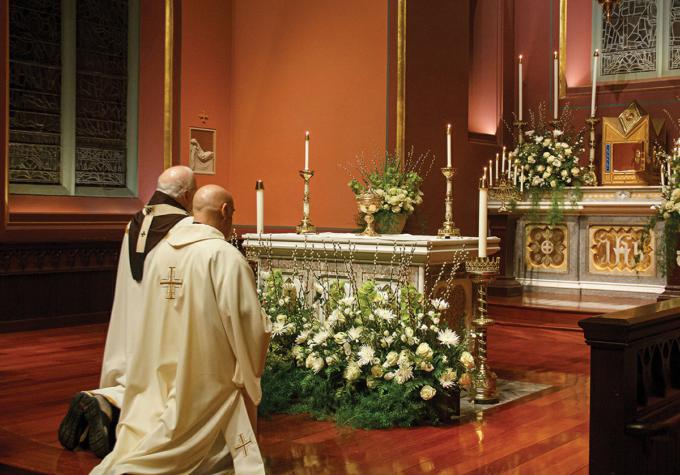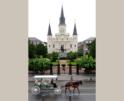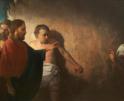
Faith
Being a member of this team requires bringing your own native gifts and your artist's eye, and placing it at the service of your parish.

O'Grady
You probably have walked into a church and thought or said -- "This is a beautiful church." This might be inspired by its architecture, its interior design, its stained-glass windows, or its finely arranged décor and its overall cleanliness. Or some blend of some or all of those aspects of a "beautiful church."
A second thought would appropriately be, "Who makes this happen?" "How is this building so welcoming in spite of its great size, its vaulted ceiling, its expansive sanctuary?" Or "It's amazing how this little country church accomplishes all those qualities of a cathedral."
You can probably bet it's the pastor and liturgical environment team.
This liturgical ministry (and it is that) is another of the hidden ones, and another that is composed overwhelmingly of women. They are, in a very real sense, artists.
They seem to have an eye for detail. This flower or plant fits well here. This piece of furniture is in the way. Can you move that out of here for the Advent season? This will add a lot to the Easter season.
Being a member of this team requires bringing your own native gifts and your artist's eye, and placing it at the service of your parish.
Here are some thoughts for existing teams or if you are asked to join a team.
The liturgy requires beauty to show forth the sacred mystery it is celebrating. The space needs to be welcoming, and the relationships between spaces, articles, decoration, flowers, etc., have to fit the sacred space. The altar cannot be hidden or obscured under mounds of lilies or poinsettias. If you have lots of them, spread them around the entire church.
The environment has to invite and not obstruct the prayer and the participation of the gathered assembly.
Nothing but the best and the most for God is an old maxim. This includes having everything be quality. And it includes keeping everything "real." Plastic, silk, or other "unreal flowers" are not the "best for God." Altar candles and all candles are wax, not plastic tubes filled with oil cans. They are neater and more efficient, but for God, real is best.
The team must be alert to the church's calendar and the color schemes that flow from it.
Members must work especially in collaboration with the church's custodial team and the sacristans to ensure that all is in good order for every Mass and other liturgy.
The sanctuary has to allow the easy movement of any ministers using it. As much as possible, the whole church needs to be accessible to all.
The space for reconciliation needs to be exclusively for that sacrament. More than a few churches have been known to use the "unused confessionals" as storage space. And the team needs to ensure that that space is inviting, clean, and lighted.
The water in the baptismal font and all the stoups at the church's doors should be regularly replaced, and receptacles regularly cleaned.
The ambo or lectern should be free from anything except the lectionary. The microphone should be easily adjustable and checked regularly for wear and tear.
The altar should stand forth as the focus of the whole church. Covering it with a simple white cloth is sufficient. Any decoration ought to be around the altar but not so arranged as to obstruct the rest of the assembly's sightlines. Candles are preferably on stands near the altar rather than on it, again to give a clear view to all in the church.
Preference is always to be given to what is genuinely needed for the liturgy rather than the individual desires or well-meaning suggestions of either team members, parishioners, or pastors! There is a wonderful piece of advice for the Second Vatican Council: "Let the rites radiate a noble simplicity." It's hard to describe in words, but you know it when you see it.
Flags, whether national or other, need to be considered carefully. The question of placement can be an issue. Most parishes proudly feature the stars and stripes somewhere on the church property, which are often prominently lighted at night.
Which brings up the exterior input from the environment team. The team's ministry goes beyond the church's doors in assisting the pastor in the appropriate arrangement of seasonal décor that draws parishioners and neighbors to the church itself and says, "Come in for Easter." Or "It's Christmas, welcome."
There are interlocking and overlapping responsibilities for ministers of the liturgical environment. So, the team's spirit has to be embracing of other ministries.
Here are a few references, whether you are presently serving your parish's liturgical environment or asked to do so.
From the Diocese of Green Bay, very helpful guidelines: www.gbdioc.org/images/stories/Resource_Site/Worship/Guidelines-Resources-Ministries-Environment-Art-Sacristans.pdf
From The Liturgical Ministry series:
"Guide for Ministers of Liturgical Environment, Second Edition" (2021) by Paul Turner Corinna Laughlin, Mary Patricia Storms.
And, an excellent book for a pastor with sound practical advice:
"The Liturgical Environment: What the Documents Say'' (2015) by Mark G. Boyer.
Recent articles in the Faith & Family section
-
Our Lady of DeliveranceJaymie Stuart Wolfe
-
The 'month of the dead' brings its own strange refreshmentBishop Robert Reed
-
Make New Friends, But Keep the OldMaureen Crowley Heil
-
A royal truthScott Hahn
-
St. Cecilia and hope in sacred songRichard Clark


















